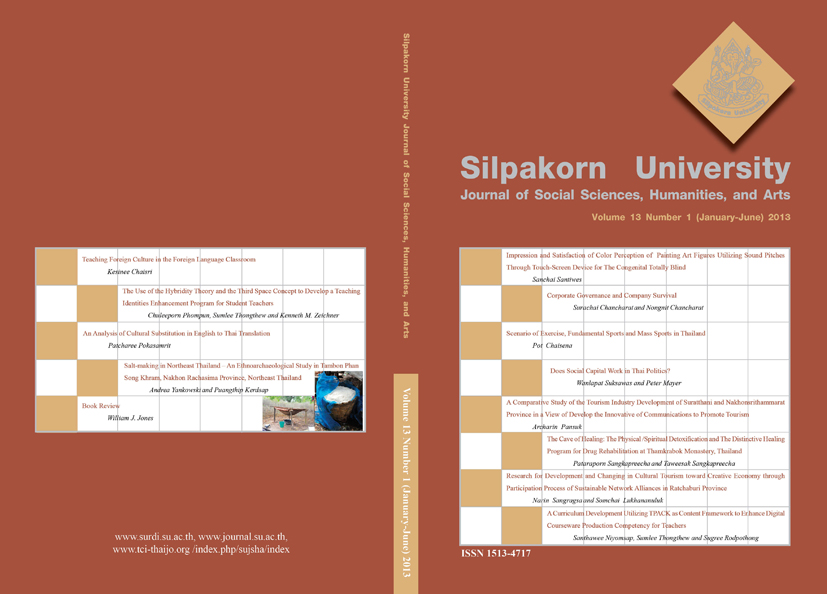An Analysis of Cultural Substitution in English to Thai Translation
Main Article Content
Abstract
Cultural substitution refers to the translation of some known or unknown concepts in the source language by using the substitution from the culture of the receptor language rather than by other available means of meaning equivalence. For examples, a black sheep is translated into literal Thai as a cub outside a pen rather than a person with different and unacceptable characters, and a corner stone is translated as a supreme pole, rather than an indispensable and fundamental basis. This study analyzes cultural substitution in English to Thai translation in order to document its types, linguistic patterns, and cultural significance; and to find and draw conclusions as to the translators’ opinion of this technique. In the first part of the study, culturally substituted items were randomly collected from 1000 pages of different types of English to Thai translated works which were published during B.E. 2542 (1997) to B.E. 2552 (2007). These data were then classified and listed according to their generic types and presented in categorized tables with their linguistic and cultural comments as findings. In the second part, 12 translators whose works have been published during the past 10 years were asked to fill in questionnaires and interviewed on their opinions on cultural substitute translation technique. The conclusions of the opinions are provided, and the recommendations for the use of the findings and for further research are offered.
Downloads
Article Details
All rights reserved. Apart from citations for the purposes of research, private study, or criticism and review,no part of this publication may be reproduced, stored or transmitted in any other form without prior written permission by the publisher.
References
Bell, T. R. (1991) Translation and Translating: Theory and Practice. New York : Longman Inc.
Brown, G. and Yule, G. (1983) Discourse Analysis. Cambridge : Cambridge University Press.
Cambridge Advanced Learner’s Dictionary. (2003) Cambridge University Press (2nd ed.). [Online URL:www.dictionary.cambridge.org/cald/.] accessed on October 21, 2006.
Denoun, E. (2000) Translation and Culture. [Online URL: https://www.completetranslation.com/culture.htm.] accessed on August 15, 2010.
Fromkin, V. and Rodman, R. (1993) An Introduction to Language. Texas : Harcourt Brace College Publishers.
Goedde, B. (2007) The New York Times; Nonfiction in Translation. [Online URL: https://www.creativenonfiction.org/brevity/craft_goedde.htm.] accessed on January 15, 2009.
Grice, H. P. (1975) Logic and Conversation, in Cole P. and Morgan, J. L. (eds.), Syntax and Semantics. Vol. 3. Speech Acts. New York : Academic Press.
Hatim, B. and Mason, I. (1990) Discourse and the Translator. New York : Longman Inc.Hariyanto, S. (1996) Implication of Culture on Translation Theory and Practice. Malang : State Polytechnic.
Himmelmann, N. P. and Bochum, R. (2007) [Online URL: https://enwiki-pedia.org/wiki/linguisticdescription.]
Himmelmann, N. P. and Bochum, R. (1998) “Documentary and Descriptive Linguistics” Linguistics, Vol. 36.
Karamanian, A. P. (2002) Translation and Culture. Translation Journal, 6(1), January 2002. [Online URL:https://accurapid.com/journal/19culture2.htm.] accessed on December 9, 2006.
Katz, J. (1972) Semantic Theory. New York : Harper & Row.
Kempson, R. M. (1996) Semantic Theory. Cambridge : Cambridge University Press.
Kreidler, C. W. (1998) Introducing English Semantics, London : Routledge.
Kurland, J. D. (2000) Fiction vs Nonfiction. [Online URL: https:// www.criticalrcading.com/fictionvnonfiction.htm.] accessed on January 19, 2009.
Larson, M. (1998) Meaning-Based Translation: A Guide to Cross-Language Equivalence. Oxford : University Press of America.
Larson, R and Segal, G. (1995) Knowledge and Meaning: An Introduction to Semantic Theory. USA : Massachusetts Institute of Technology.
Lyons, J. (ed) (1997) Semantics. Cambridge: Cambridge University Press.
Munday, J. (2001) Introducing Translation Studies: Theories and Applications. London : Routledge.
Newmark, P. (1992) Approaches to Translation. Cambridge: Cambridge University Press.
Newmark, P. (1995) Approaches to Translation. London : Phoenix ELT.
Nida, E. A. and Taber, C. R. (1982) The Theory and Practice of Translation. Leiden : E. J. Brill.
Nida, E. A. (2001) Contexts in Translating. Amsterdam : John Benjamins.
Oxford Advance Lemer’s Dictionary (2000) International Student’s Edition(6th ed.). England : Oxford University Press.
Parkinson, G. (1982) The Theory of Meaning. Oxford : Oxford University Press.Pokasamrit, P. (1999, December 7) “Translate it”. Bangkok Post, Classified.
Pokasamrit, P. (2005) An Analysis of Linguistic, Functional, and Socio-cultural Characteristics of Loan Translation: A Case Study of English-Thai Translation. Paper Presented at the International Conference on “Language, Communication, and Culture: Dialogues and Contexts in Focus”.
Pokasamrit, P. (2006) English to Thai Translation: Theories and Techniques. Bangkok: The National Institute of Development Administration (in Thai)
Pokasamrit, P. (2011) An Analysis of Pronoun Translation from English into Thai. Bangkok: The National Institute of Development Administration (in Thai)
Samovar, L. A., Porter, R. E., and Stefani, L. A. (1998) Communication Between Cultures. Belmont: Wadworth.
Spolsky, B. (1998) Sociolinguistics. Oxford : Oxford University Press.
Thriveni, C. (2002) Cultural Elements in Translation. Translation Journal, 6(1), January. [Online URL:https://accurapid.com/journal/19culture.htm.] accessed on January 08, 2009.
Toury, G (2000) Descriptive Translation Studies-and Beyond. Shanghai : Shanghai Foreign Language Education Press.


